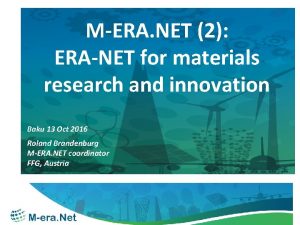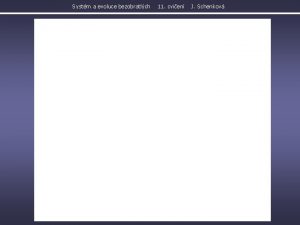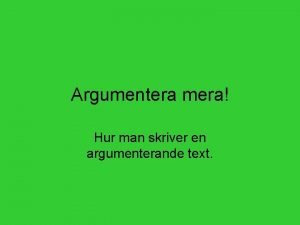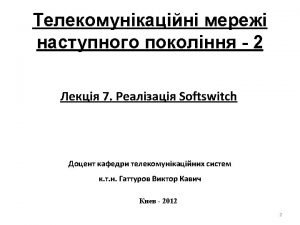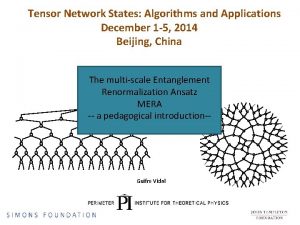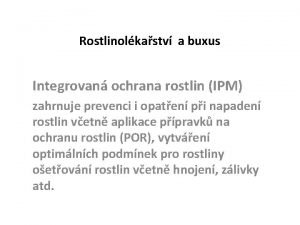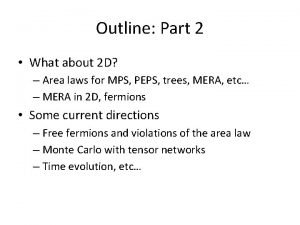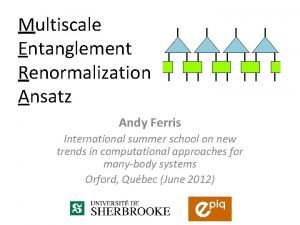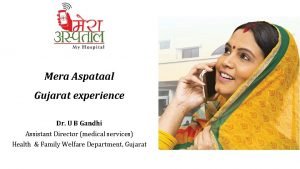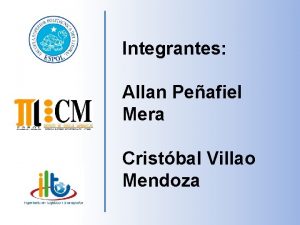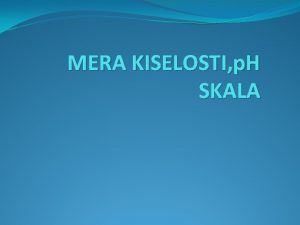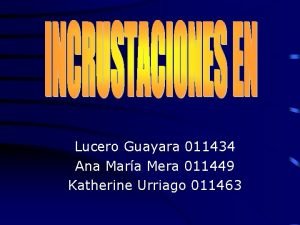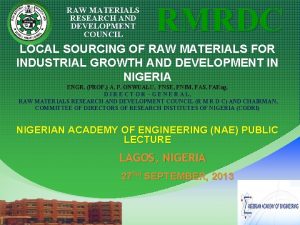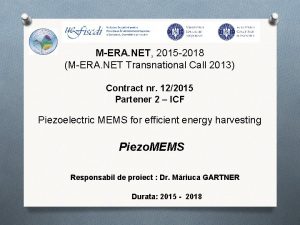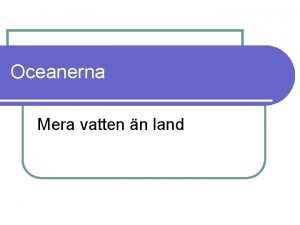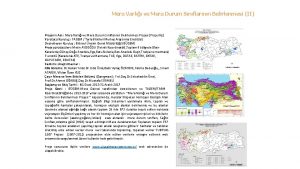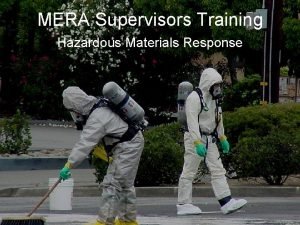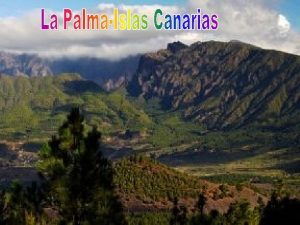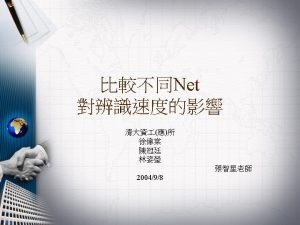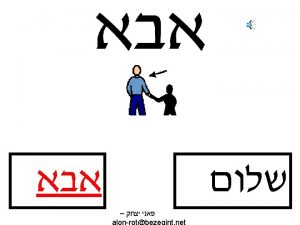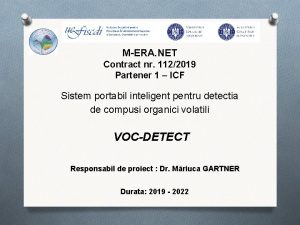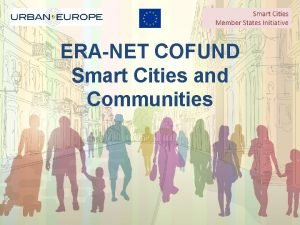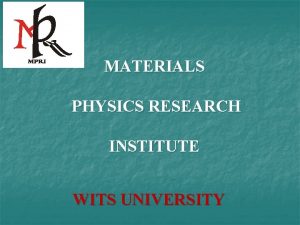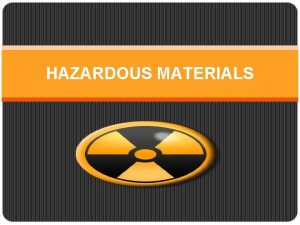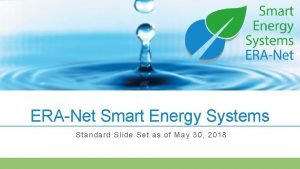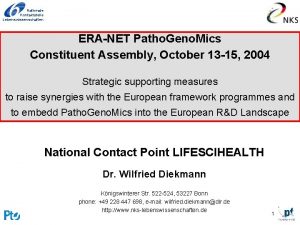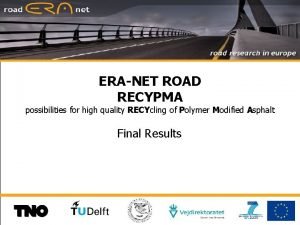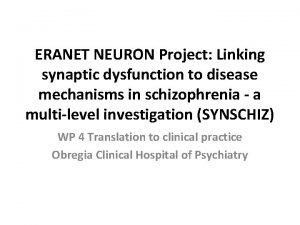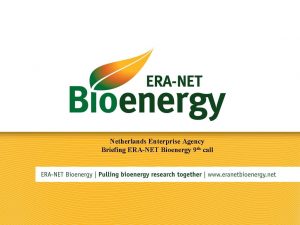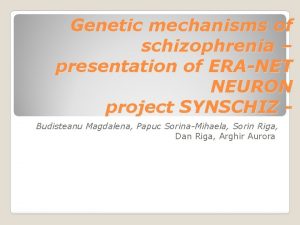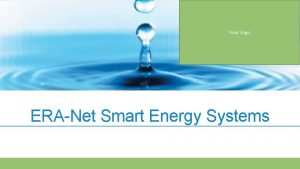MERA NET 2 ERANET for materials research and





















- Slides: 21

M-ERA. NET (2): ERA-NET for materials research and innovation Baku 13 Oct 2016 Roland Brandenburg M-ERA. NET coordinator FFG, Austria

(Pre-)History: FP 6 -FP 7 MNT-ERA. NET MATERA(+) M-ERA. NET • MNT-ERA. NET (2004 -2008): micro & nano technologies • MATERA (2005 -2011): materials • MNT-ERA. NET II (2009 -2011): micro & nano technologies • MATERA+ (2009 -2013): materials together: ~150 funded projects, >100 MEUR public funding • M-ERA. NET: 2/2012 -1/2016 • materials science and engineering • large network: 37 funding organisations: 29 national + 8 regional 25 European countries • many “observers”, incl. non-European

The M-ERA. NET main activities 2012 -2015 • joint strategic programming of joint activities • annual joint calls for transnational RTD proposals • additional activities: programme surveys, database of research infrastructures, clusters & competence centres • consolidation of the network, including international cooperation with appropriate partners from outside Europe • dialogue with RTD community and stakeholders: workshops, events, dissemination

Consolidation of the network 2012 -2015: • expanded European partnerships: FR, BE, ES, IE, IT, NL, PL • enlarged international cooperation: contacts established to • Taiwan: NSC/MOST (Call 2012, 2013, 2014, 2015) • Russia: FASIE (Call 2013, 2014, 2015) • South Korea: KIAT (Call 2015), NRF • Brazil: CNPq, CAPES, FAPESP (Call 2015) • Japan: JST, MEXT, NEDO, METI • Singapore: A*STAR • South Africa: DST • USA: NSF

Summary of M-ERA. NET Joint calls 2012 -2015 full documentation: https: //www. m-era. net/joint-calls Call 2012: Call 2013: 30 funding orgs. 32 funding orgs. 23 European countries 22 European countries + Taiwan + Russia + Taiwan 124 pre-proposals 72 full proposals 23 funded projects 166 pre-proposals 90 full proposals 26 funded projects • Call 2014: 36 funding orgs. 22 European countries + Russia + Taiwan 172 pre-proposals 105 full proposals 22 funded projects Österreichische Forschungsförderungsgesellschaft | Sensengasse 1 | 1090 Wien | www. ffg. at Call 2015: 35 funding orgs. 22 European countries + Brazil (Sao Paulo) + Korea + Russia + Taiwan 156 pre-proposals 94 full proposals 22 funded projects 5

Results M-ERA. NET Calls 2012 - 2015 funded applicants (average) Average project: • 3 -5 partners from 2 -3 countries • project costs 1 Mio EUR; duration 2 -3 years

A new partnership: M-ERA. NET 2 (2016 -2021): Enlarged consortium with international participation

M-ERA. NET 2 (2016 -2021) The M-ERA. NET 2 consortium (H 2020 grant agreement): 41 public funding organisations from 28 different countries already active in M-ERA. NET 4; 9% 12; 27% national 29; 64% new in M-ERA. NET 2 6; 15% regional international … + additional „observer“ participants joining selected activities 35; 85% 21 (52%) >5 years experience

M-ERA. NET 2016 -2021: Vision & Objectives Ø support the European economy towards societal and technological challenges of the 21 st century; Ø multi-annual policy for strategic programming of joint activities, allowing a flexible coverage of topics; Ø annual joint calls including 1 cofunded call with EU top-up; Ø mobilise substantial national and regional public funding; Ø emphasize low carbon energy technologies Ø cooperation with appropriate partners world-wide to facilitate access for the European RTD community to leading knowledge worldwide; Ø strengthen a long term cooperation between funding organisations.

Joint strategic programming: work programmes for joint calls programme owners (e. g. ministries): suggest thematic priorities call implementation (programme managers, e. g. funding agencies) external expertise from Strategic Expert Group (representing stakeholders, industry, academia, e. g. ETPs, research orgs. ) programme owners: - endorse work programme - individual nat/reg commitments: topics, budget, type of research, target group

Role of Strategic Experts Group (SEG) to represent industry and academic research, providing comprehensive overview on needs and possibilities at European, national and regional levels in order to identify gaps and opportunities; to analyse national/regional priorities provided by the M-ERA. NET consortium; to analyse up-to-date status and foreseen development of European strategies; to analyse results from M-ERA. NET calls Experts suggested by all M-ERA. NET partners and selected according to defined criteria (expertise, academic/industrial background, country, gender, . . ); The composition of this group is flexible in order to react to changing environments and emerging challenges.

M-ERA. NET Calls 2012 -2016: topics Call 2012 Call 2013 Integrated Computational Materials Engineering Interfaces, Surfaces and Coatings Call 2015 Call 2016 Integrated Computational Materials Engineering Integrated computational materials engineering New Surfaces and Coatings Innovative surfaces, coatings and interfaces including materials for low carbon energy technologies Design of new interfaces, surfaces and coatings Call 2014 Composite High performance synthetic Hybrid composites Technology / and biobased composites biobased materials Materials for Sustainable and Materials for energy Affordable Low systems Carbon Energy Technologies Interfaces between materials and biological Materials for Health hosts for health applications Functional Materials Functional materials Focusing on Sensors Materials science for Materials for additive manufacturing Secondary raw materials Composite Technology

Addressing the innovation chain M-ERA. NET 2 parties support (multiple answers): basic research 26; 31% 22; 26% applied research innovation 37; 43%

Participations per topic and organisation type 80 75 University Research org. 70 64 SME 60 Large industry 40 54 Other 50 42 39 36 31 30 26 20 20 10 50 47 45 37 60 28 25 20 17 9 6 10 7 2 1 2 0 Composite Technology Functional Materials Focusing on Sensors Integrated Computational Materials Engineering (ICME) Materials for Health Materials for New Surfaces and Sustainable and Coatings Affordable Low Carbon Energy Technologies

Challenge: balance available budgets and requested funding 0 10 20 30 40 50 60 70 80 AT- FFG BP AT- FFG TP BE- DGo 6 BE- FNRS BE- FWO BE- IWT CH- SERI CY- RPF DE- DFG DE- JÜLICH DE- KIT DE- VDI-TZ EE- ETAG ES- IDEPA ES- Innobasque ES- MINECO FR- CR-Limousin FR- RMP HU- NKFIH/OTKA IL- MATIMOP IL- MOST IL IS- RANNIS IT- REGIONE. . . LT- RCL LU- FNR LV- LAS NO- RCN PL- NCBi. R PT- FCT RO- UEFISCDI RU- FASIE SI- MIZS SK- SAS TR- Tübitak TW- MOST TW full-proposal recommended for funding full-proposal not funded full-proposal failed central evaluation pre-proposal rejected Calls 2012 -2014: success rates

M-ERA. NET Call 2016: • launched 15 March 2016 • committed nat/reg budget ~30 mio. € • EU top up ~ 10 mio € • deadline for pre-proposals: 14 June 2016 (233 pre-proposals) • deadline for full-proposals: 10 November 2016 • funding decision: Feb 2017

Other activities: Clusters and competence centres

Do we reach our goals ? Assessment of work programmes Methodology The annual work programmes will be assessed by analysing defined indicators in 3 main categories: a) Budgetary commitments b) Benefit for networking of programmes and agencies at national level c) Added value for the target group compared to alternative funding instruments Assessment of funded projects Methodology The funded projects are assessed via questionnaires to all parties in funded projects 1) directly after the completion of the projects 2) 3 years after the end of the projects. Success is measured by: • a) Technical results c) Economic effects • b) Scientific results d) Transnational benefit

More information: www. m-era. net • • Partner details Funding programmes Funded projects Events

Results: funded projects • central evaluation: evaluators needed! https: //m-era. net/joint-calls/become-evaluator

Thank you ! contact: office@m-era. net roland. brandenburg@ffg. at www. m-era. net
 Mera net 2021
Mera net 2021 Mera jabloňová
Mera jabloňová Tceq mera
Tceq mera Hur skriver man en argumenterande text
Hur skriver man en argumenterande text Mera softswitch
Mera softswitch Mera
Mera Cylindrocladium buxus
Cylindrocladium buxus Mera
Mera Tranformation
Tranformation Mera aspataal
Mera aspataal Allan peñafiel mera
Allan peñafiel mera Mera
Mera Joni su
Joni su Preparación inlay
Preparación inlay Cant stop the feeling go noodle
Cant stop the feeling go noodle Useful materials and harmful materials
Useful materials and harmful materials Natural man made
Natural man made Adopting and adapting teaching materials
Adopting and adapting teaching materials Direct materials budget with multiple materials
Direct materials budget with multiple materials Rmrdc salary for corpers
Rmrdc salary for corpers Kontinuitetshantering i praktiken
Kontinuitetshantering i praktiken Typiska novell drag
Typiska novell drag
